LUFTWAFFE BOMBS BRITISH CAPITAL
London, England · January 12, 1940
On this date in 1940 the German Luftwaffe conducted its first bombing raid on London, the British capital, four months after assaulting the Polish capital, Warsaw, at the start of World War II in Europe. Five months later, on May 10, the Royal Air Force retaliated with its first strategic bombing raid on Germany. On November 14, 1940, nearly 450 German bombers rained more than 500 tons of high-explosive bombs and some 56 tons of incendiary bombs on the English medieval cathedral city and industrial-munitions center of Coventry. The raging inferno destroyed or damaged 80 percent of the city center, including its cathedral, and about three-quarters of the city’s factories. Civilian dead numbered 568. Next year, in mid-April 1941, the Luftwaffe bombed and damaged London’s St. Paul’s Cathedral, initiating the final phase of the London Blitz, which reached a climax on May 10 with a raid on the British capital that hit the House of Commons, Westminster Abbey, and the British Museum, leaving a third of London’s streets impassable, 1,400 civilians dead, and 1,800 injured.
The principle of proportionality—ensuring that damage to noncombatants was not out of proportion to the potential military advantage—was forever laid to rest when the RAF and the U.S. Eighth Air Force, which was based in Britain, firebombed Germany’s second largest city, the port city of Hamburg, in late July and early August 1943. The British threw 2,355 sorties at Hamburg in three massive nighttime raids on July 24–25, July 28, and July 30, and the Eighth Air Force generated 235 daylight sorties in two raids on July 25 and 26. Operation Gomorrah—the “wrath of God” nature implied in its name—precipitated a firestorm of biblical proportions that killed at least 40,000 civilians who were blown apart, burned in the above-ground flames and melting asphalt of city streets, or were asphyxiated as they huddled in basements and bomb shelters.
The 1945 air offensive against Nazi Germany—a kind of war within a war consisting of 404 day- and nighttime bombing raids between January 2 and April 22, when the last strategic bombing raid took place—left that nation completely crippled and incapable of mounting the sort of ground defense that was needed to fend off Allied invasions on the western and eastern fronts.
![]()
The Blitz, Germany’s Strategic Bombing of Great Britain, September 7, 1940, to May 21, 1941
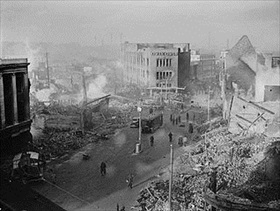 | 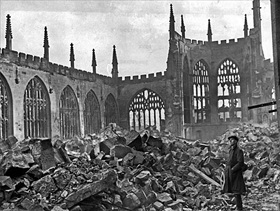 |
Left: Broadgate in Coventry city center on November 16, 1940, following the Coventry Blitz of November 14/15. The burnt-out shell of the Owen department store, opened in 1937, overlooks a scene of devastation.
![]()
Right: The Coventry Cathedral provost and a party of helpers attempted to deal with the first set of incendiary bombs that burst through the cathedral roof and walls by smothering the flames with sand. But another shower of incendiaries accompanied by high explosives, oil bombs, and land mines forced the party to give up its efforts. By the next morning only the skeleton of the cathedral was left standing.
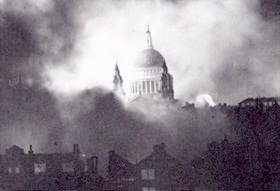 | 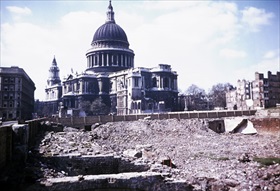 |
Left: London’s St Paul’s Cathedral, undamaged, ringed by clouds of smoke in this iconic photograph taken on December 29, 1940. The cathedral was struck four times—in September, October, and December 1940 and in April 1941—during the Blitz, the period from fall 1940 through spring 1941. Less familiar in the public’s mind was the Luftwaffe’s Blitz that occurred between January and May 1944. Operation Steinbock, as the Germans called their final air campaign over Britain, cost the Luftwaffe dearly—330 aircraft and their crews, or one bomber and four trained crewmen killed or captured for every five people killed on the ground.
![]()
Right: Color image shows the destruction of many of the buildings surrounding St. Paul’s Cathedral, which remained largely undamaged. The Germans deliberately targeted the “Square Mile,” the heart of the London and the site of some of its greatest landmarks.
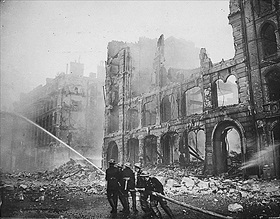 | 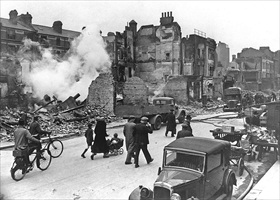 |
Left: Firefighters put out a blaze in London after an air raid during the Blitz in 1941. Less than halfway into the 37 weeks of the Blitz (September 7, 1940, to May 10, 1941), the Luftwaffe had dropped more than 13,000 tons of high explosives and nearly 1,000,000 incendiaries on London..
![]()
Right: A street of ruined houses in London. More than one million London houses were destroyed or damaged and close to 20,000 killed during the 267 days of the Blitz. Following the Blitz the Germans began firing V‑1 and V‑2 rockets into the Greater London area, destroying 24,000 houses and damaging a further 760,000 dwellings and rendering them uninhabitable. Total British personnel losses in air raids during World War II were approximately 60,000 dead.
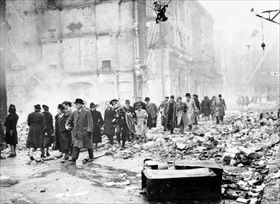 | 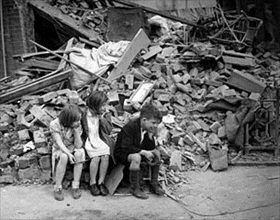 |
Left: Following an intense overnight raid, Londoners summoned up their “blitz spirit” to navigate through rubble-strewn streets on their way to work.
![]()
Right: Children of an eastern suburb of London made homeless by the Blitz. Though militarily ineffective, the Blitz caused enormous damage to Britain’s infrastructure and housing stock.
Hamburg im Feuersturm, Contemporary Newsreel Footage of Anglo-American Operation Gomorrah, July–August 1943
![]()

 History buffs, there is good news! The Daily Chronicles of World War II is now available as an ebook for $4.99 on Amazon.com. Containing a year’s worth of dated entries from this website, the ebook brings the story of this tumultuous era to life in a compelling, authoritative, and succinct manner. Featuring inventive navigation aids, the ebook enables readers to instantly move forward or backward by month and date to different dated entries. Simple and elegant! Click
History buffs, there is good news! The Daily Chronicles of World War II is now available as an ebook for $4.99 on Amazon.com. Containing a year’s worth of dated entries from this website, the ebook brings the story of this tumultuous era to life in a compelling, authoritative, and succinct manner. Featuring inventive navigation aids, the ebook enables readers to instantly move forward or backward by month and date to different dated entries. Simple and elegant! Click 











